Dark Tourism Statistics By Market Size, Demographics and Facts (2025)
Updated · Sep 12, 2025
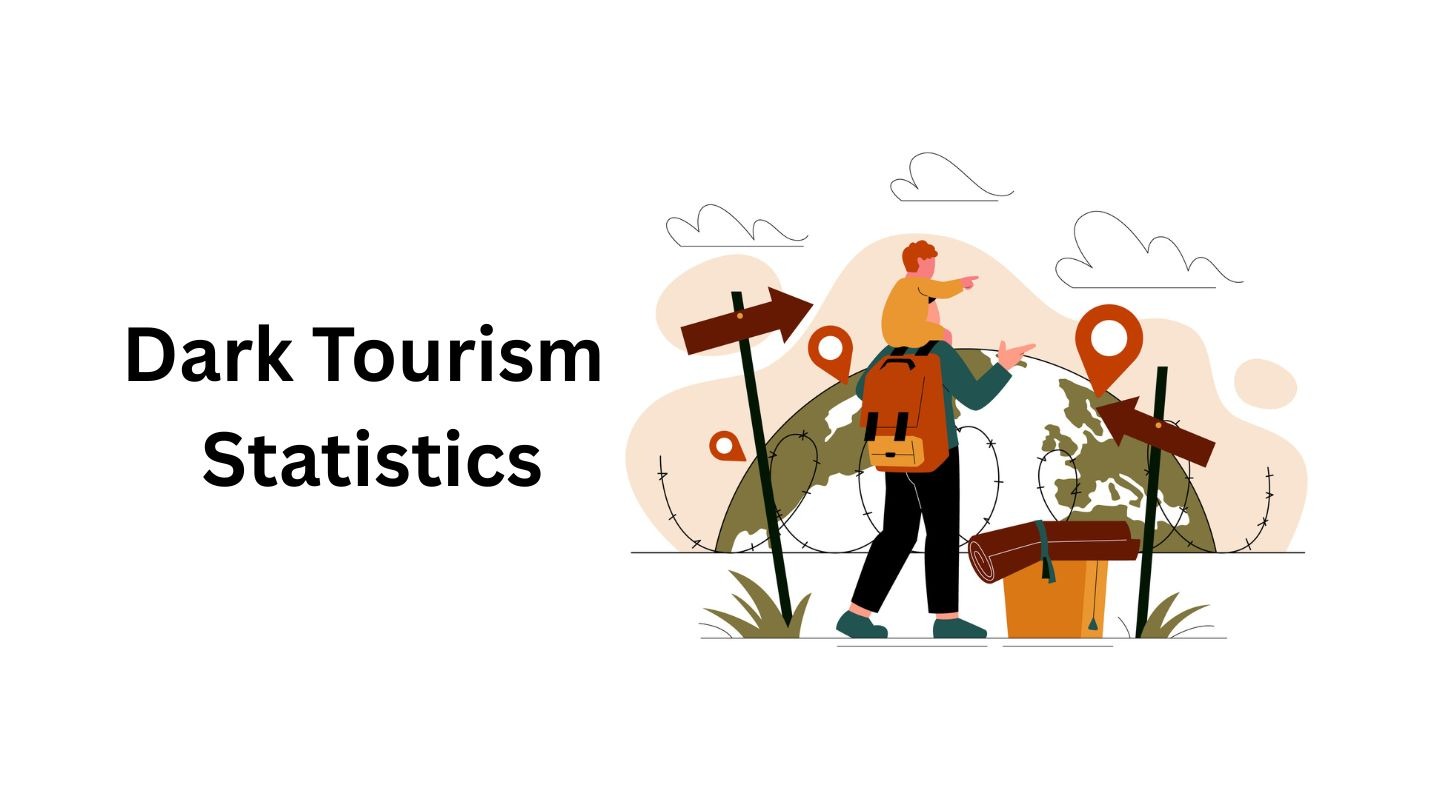
Table of Contents
- Introduction
- Editor’s Choice
- Dark Tourism Spectrum
- Dark Tourism Market Statistics
- Types of Dark Tourism
- By Category-Wise
- By Country-Wise
- By User Demographics
- By Top Destination
- Top 10 Most Popular Dark Tourism Sites
- Ethical Issues and Debate in Dark Tourism
- Reasons Behind Dark Tourism Engagement
- Main Reasons Travelers Avoid Dark Tourism
- Curiosity and Connection About Dark Tourism
- Dark Tourism Themes Analysis
- Top 5 Companies Driving the Dark Tourism Sector
- Conclusion
Introduction
Dark Tourism Statistics: Dark tourism, also known as thanatourism, is about visiting places linked to death, pain, or tragic events. These can include old battlefields, former prisons, cemeteries, memorials, concentration camps, areas where genocide happened, and locations struck by natural disasters.
Even though it can be a sensitive topic, this kind of travel can help people learn, remember, and reflect on difficult parts of history. In recent times, it has become more popular around the world, boosted by social media, documentaries, and a growing curiosity about history’s darker side.
Editor’s Choice
- The market size of the global Dark Tourism is expected to be worth around USD 31.5 billion, up from USD 30.5 billion in 2024.
- Coherent Market Insights reports that in 2025, overseas visitors will make up 61.7% of the dark tourism market.
- In the same duration, the North American region led the global dark tourism market, holding 38.3% of the total share.
- As mentioned in passport-photo.online, about 82% of Americans have already been to a dark tourism site.
- According to us, nearly one million people visit Gettysburg National Military Park each year to learn about its history.
- Global searches for Edinburgh Castle jumped 5,000%, showing rising interest from ghost hunters and medieval history fans worldwide.
- After the HBO show “Chernobyl,” visitor numbers to the Chernobyl Zone rose by 30% to 40%.
- UNESCO says about 5 million students now study higher education in other countries worldwide.
- The U.S. government supports dark tourism, shown by a USD 2.5 million grant to New York’s National September 11 Memorial & Museum.
- The UNWTO says global tourism will return to pre-pandemic levels by late 2024, hitting 97% recovery in early 2024.
- Passport Photo Online shows that dark tourism attracts many people, and in the U.S., about 82% have been to such places, mostly to learn (52%) or to honour and remember (47%).
- The top destinations include Pearl Harbour National Memorial, Hawaii (45%), Ground Zero, New York (44%), and the Catacombs of Paris, France (43%).
- Most people view dark tourism positively, with 46% holding a good opinion and 18% seeing it very favorably, while only 9% oppose it.
- However, 57% dislike tourists taking selfies at tragic sites.
Dark Tourism Spectrum
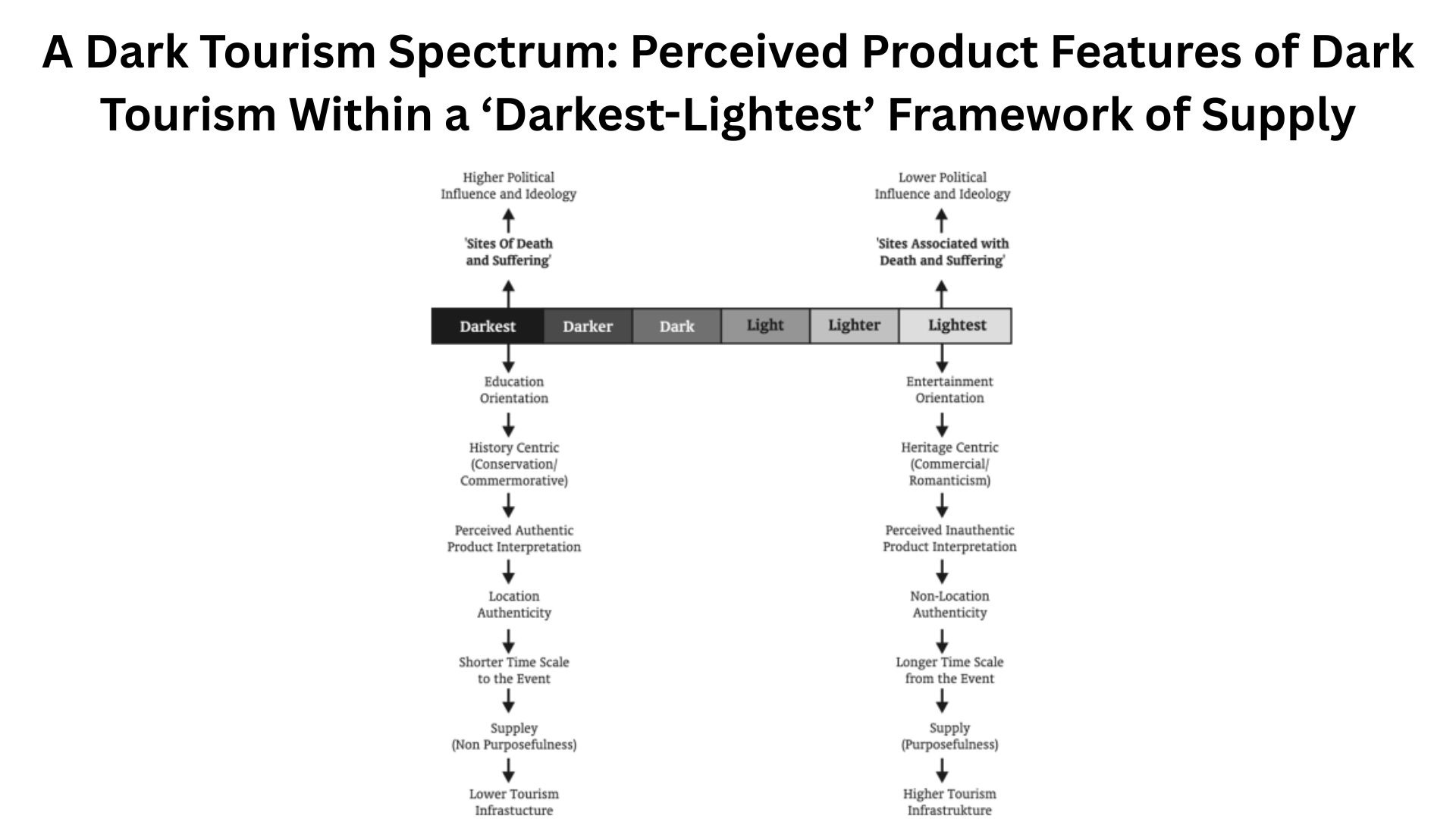
- The “Darkest–Lightest” framework classifies dark tourism sites along a spectrum based on authenticity, historical proximity, and visitor purpose. At the darkest end are locations of actual death and suffering, such as battlefields or concentration camps, often politically significant and preserved for education and commemoration. These sites have strong location authenticity, a close time link to the event, minimal tourism infrastructure, and non-commercial intent.
- Moving toward the lightest end, sites shift from historical conservation to entertainment, with heritage interpreted commercially or romantically. These locations may be far removed from the original event in both time and place, sometimes offering only symbolic or recreated experiences. Tourism here is highly purposeful, with well-developed infrastructure designed for large audiences.
Dark Tourism Market Statistics
- The Global Dark Tourism Market is projected to grow from USD 29.6 billion in 2023 to USD 40.2 billion by 2033, at a compound annual growth rate (CAGR) of 3.1% from 2024 to 2033.
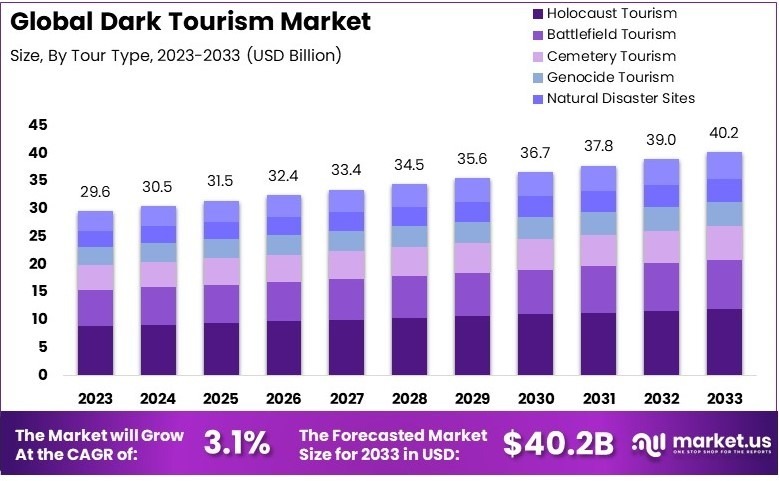
- Edinburgh Castle has experienced a remarkable 5,000% increase in global search interest, indicating a surge in ghost-hunting tourism and a growing fascination with medieval history.
- The Chernobyl Exclusion Zone saw an increase in visitors ranging from 30% to 40%, largely driven by the popularity of the HBO miniseries “Chernobyl.”
- Dark tourism plays a significant role in education and cultural remembrance. Approximately 5 million international students studying abroad often visit these sites for educational purposes.
- The National Park Service allocated a grant of $2.5 million to the National September 11 Memorial & Museum to support educational programs and preserve historical sites.
- In 2023, the dark tourism market was valued at USD 29.6 billion and is projected to grow to USD 40.2 billion by 2033, with an annual growth rate of 3.1%.
- Holocaust tourism was the largest segment of the market in 2023, accounting for 29.6% due to its educational and historical significance.
- Domestic tourism led the market, comprising 62.6% of visitors in 2023, which reflects a strong local interest in dark tourism sites.
- In 2023, 64.2% of bookings for dark tourism were made directly, indicating a preference for more personalized booking options.
- The Asia Pacific region accounted for 32.4% of the dark tourism market in 2023, signifying strong growth and interest in the area.
- A survey conducted by Passport Photo Online revealed that 82% of Americans have visited at least one dark tourism site, motivated by educational interests (52%) and a desire to pay tribute (47%).
- Popular dark tourism sites in the U.S. include the Pearl Harbor National Memorial (45%), Ground Zero (44%), and the Catacombs of Paris (43%).
Types of Dark Tourism
- According to Passport-Photo. Online, 56% of American travellers claimed war/battlefields as the most appealing dark tourism destination, while another 56% claimed disaster tourism.
- Furthermore, other types of dark tourism destinations preferred by Americans are 53% (Cemetery tourism), 52% (Ghost tourism), 50% (Nuclear tourism), 49% (Holocaust genocide tourism), and 48% (Prisons and persecution site tourism).
By Category-Wise
- Coherent Market Insights reports that in 2025, overseas visitors will make up 61.7% of the dark tourism market.
- Based on types, Holocaust-related tourism will account for a market share of 32.9%.
- According to Grand View Research, paranormal tourism is expected to grow by 4.1% annually from 2024 to 2030, while solo dark tourism should rise by 2.8% each year.
- In 2023, domestic trips made up 65.9% of revenue, and international visits are predicted to increase by 4.3% from last year.
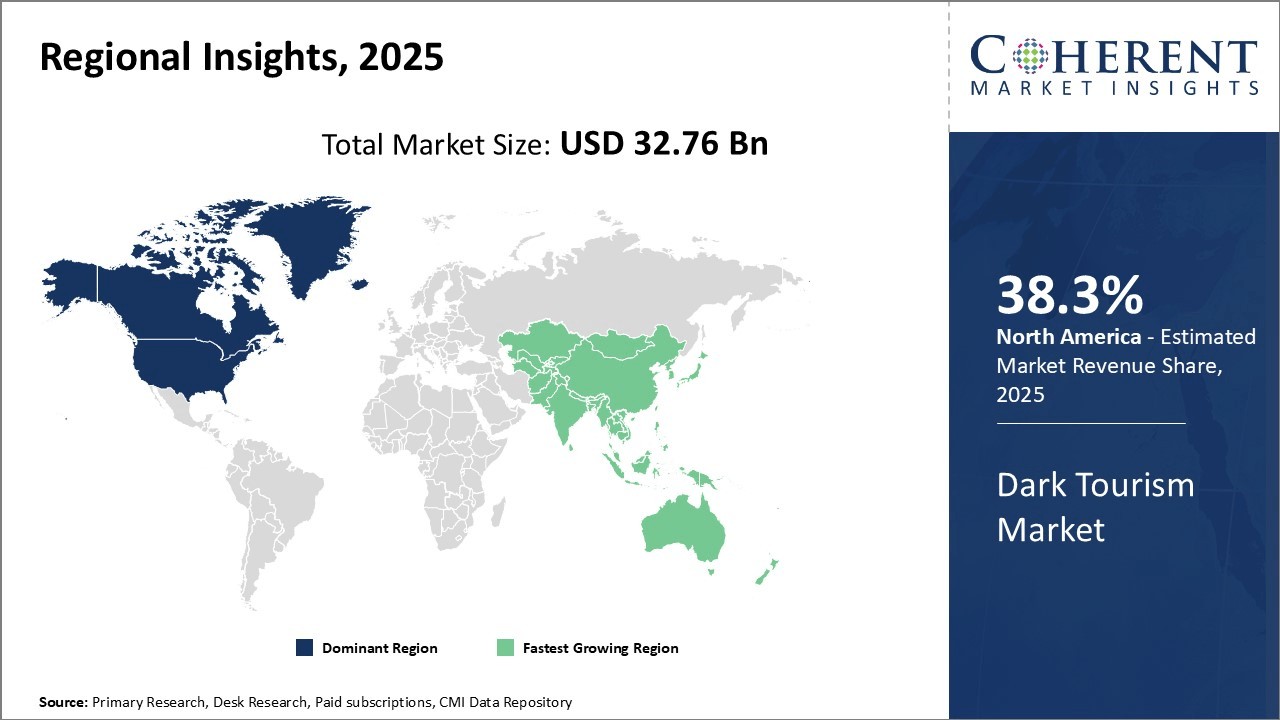
- In 2025, North America was the biggest part of the dark tourism market, making up 38.3% of it.
- At the same time, 43.6% of bookings were made online because using the internet is easy and widely available.
By Country-Wise
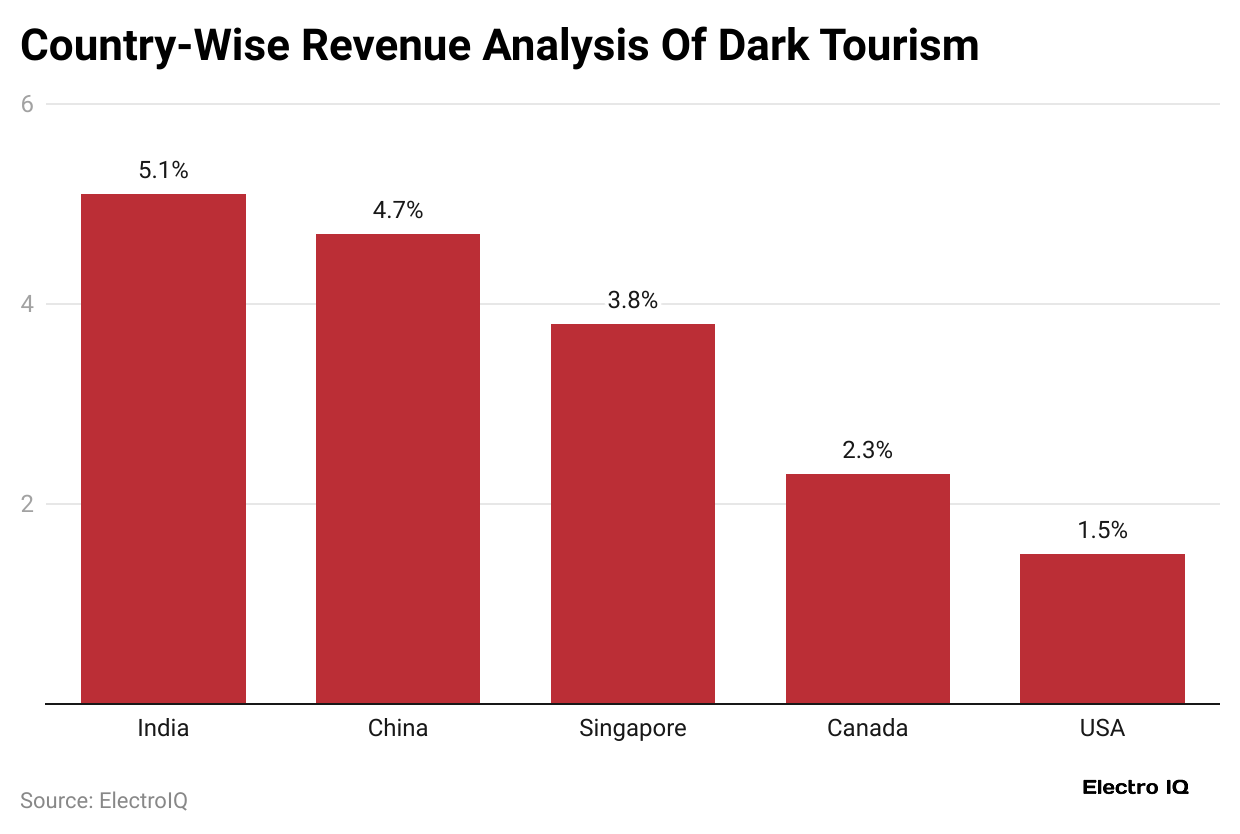
- A report published by Future Market Insights shows India accounts for the leading dark tourism place, with an estimated 5.1% CAGR (Compound Annual Growth Rate) from 2024 to 2034.
- Indian dark tourism places include the Cellular Jail National Memorial and Jallianwala Bagh.
Other Countries’ CAGRs are stated in the table below:
| Country | Approx. CAGR (2024 to 2034) | Dark Tourist Places |
| China | 4.7% |
The Nanjing Massacre Memorial and the Great Wall. |
|
Singapore |
3.8% | Changi Museum and the Old Ford Factory |
| Canada | 2.3% |
The Halifax Explosion Memorial and the Museums |
|
The United States |
1.5% |
Alcatraz Island and Ground Zero |
By User Demographics
- A recent study shows that 82% of Americans have already visited at least one dark tourism site, including 83% of men and 81% of women.
- Among the 18% who haven’t, 63% are still interested in dark tourism.
- Based on age group, around 91% of Gen Z remained the highest visitors of dark tourism.
- Others are followed by Millennials (83%), Gen X (80%), and Baby Boomers (71%).
By Top Destination
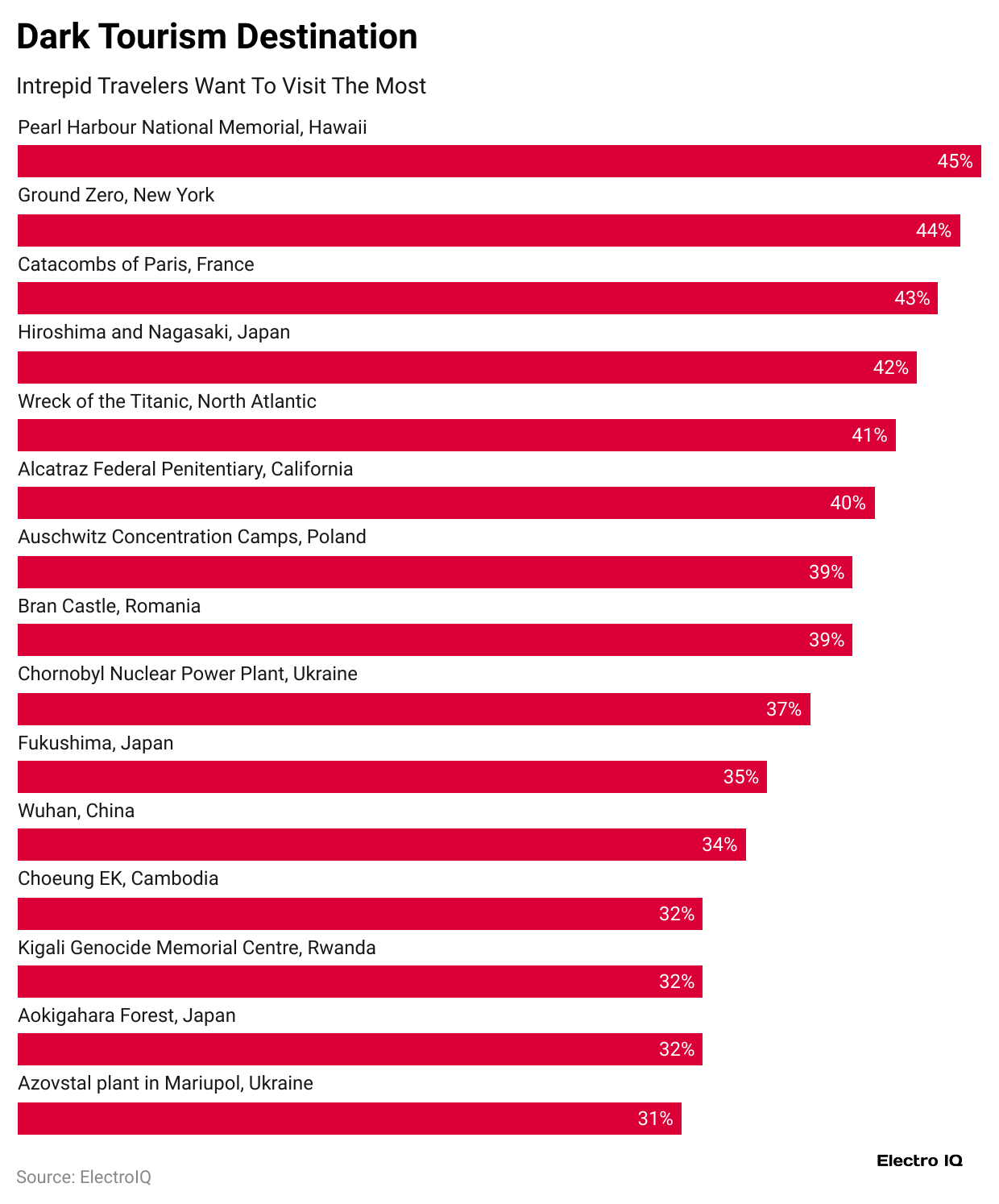
- The above image shows that the top destinations include Pearl Harbour National Memorial, Hawaii (45%); Ground Zero, New York (44%); Catacombs of Paris, France (43%); Hiroshima and Nagasaki, Japan (42%); and Wreck of the Titanic, North Atlantic (41%).
- Others are followed by Alcatraz Federal Penitentiary, California (40%), Auschwitz Concentration Camps, Poland (39%), Bran Castle, Romania (39%), Chornobyl Nuclear Power Plant, Ukraine (37%), Fukushima, Japan (35%), Wuhan, China (34%), Choeung EK, Cambodia (32%), Kigali Genocide Memorial Centre, Rwanda (32%), Aokigahara Forest, Japan (32%), and Azovstal plant in Mariupol, Ukraine (31%).
Top 10 Most Popular Dark Tourism Sites
- Some of the world’s most visited dark tourism sites include the National 9/11 Memorial & Museum in New York, drawing about 4 to 5 million visitors each year, and Auschwitz in Poland, visited by over 2 million people.
- Other popular spots are Alcatraz in San Francisco, the USA, the Arizona Memorial at Pearl Harbour, and the ruins of Pompeii in Italy.
- In Berlin, dark historic sites like the Berlin Wall and Checkpoint Charlie attract many tourists, while Arlington National Cemetery in Washington, D.C., also receives large crowds.
- The Paris Catacombs in France, the Anne Frank House in Amsterdam, and Hiroshima in Japan remain significant destinations for remembrance and learning.
Ethical Issues and Debate in Dark Tourism
- A survey found that most people view dark tourism favourably, with 46% holding a positive opinion.
- In contrast, only 18% feel very positive about it.
- Meanwhile, 27% are neutral, 7% hold a negative opinion, and only 2% see it very negatively.
- Around 57% of travelers feel unhappy about people clicking selfies at tragic sites.
- In the U.S., 51% dislike visitors who ignore regulations at places linked to dark tourism.
Reasons Behind Dark Tourism Engagement
- A report published by Passport Photo Online shows that globally, 52% of people are currently enjoying the educational aspects of dark tourism.
- In contrast, 47% contributed tribute to the affected people by the particular grief event.
- Meanwhile, the other reasons are as follows: 46% felt emotionally absorbed in a place of tragedy.
- About 45% of people preferred exploring places with meaningful stories instead of going to popular tourist spots.
Main Reasons Travelers Avoid Dark Tourism
- Some people see problems with dark tourism. About 22% feel it takes advantage of human suffering.
- Around 18% think these places hide or change parts of history, and another 18% say it disrespects sites of tragedy.
- Meanwhile, 16% don’t see the attraction, but 13% find it inappropriate, and 12% call it voyeuristic.
Curiosity and Connection About Dark Tourism
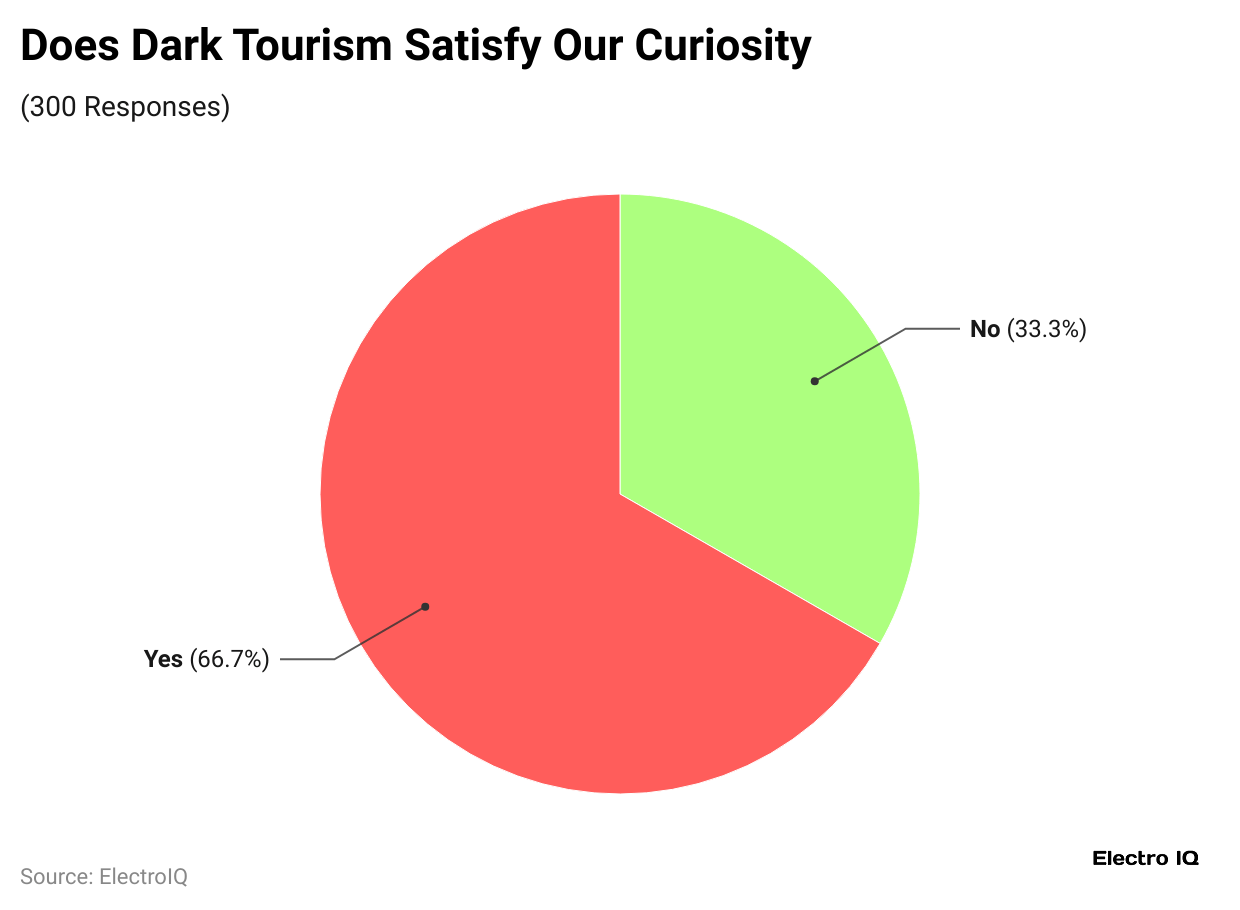
- A recent survey asked 300 people aged 26 to 35 about dark tourism.
- In which women made up 57% of those surveyed.
- When asked, “Does dark tourism satisfy our curiosity?” about 66.7% said yes, while the remaining 33.3% answered no.
Dark Tourism Themes Analysis
- Conflict and War: Many dark tourism places are linked to wars and battles, giving visitors a chance to learn about military history and the heavy human cost of conflict.
- Tragedy and Disaster: Others focus on disasters, whether natural or artificial, helping people understand their impact and lessons.
- Death and Suffering: Some locations, such as cemeteries or execution grounds, reflect how different cultures face death and loss.
- Crime and Punishment: Sites related to crime and punishment, like old prisons or courtrooms, reveal stories of justice and injustice.
- Anthropological Significance: Places showing how people mourn and handle death reveal their culture, traditions, and beliefs about life and loss.
Top 5 Companies Driving the Dark Tourism Sector
| Company | Focus |
| Atlas Obscura | Focuses on creating unique dark tourism trips to unusual, eerie places that reveal hidden history. |
| Dark Rome Tours | Offers tours of historic places, highlighting dark stories like gladiators in the Colosseum and Rome’s catacombs. |
| Dark Tourism Group | Provides various tours to places linked to death, disasters, and tragedies like Auschwitz and Chernobyl. |
| Anne Frank House | The site teaches about Anne Frank and the Holocaust, encouraging learning, tolerance, and respect. |
| Auschwitz-Birkenau Memorial and Museum | It is a serious place to remember the Holocaust and learn about its sad history through tours. |
Conclusion
Dark tourism lets people connect with some of history’s most serious and emotional events. Visiting places tied to tragedy helps visitors understand what happened and the people involved. This kind of travel promotes learning, reflection, and respect for those affected. Although it can raise ethical concerns, dark tourism also preserves important memories and teaches future generations.
As more people become interested in it around the world, it’s important to visit these sites with care and respect so that the stories are honored and not treated like entertainment.
Sources
FAQ.
The term “dark tourism” was first created in 1996 by Scottish professors John Lennon and Malcolm Foley.
In dark tourism, always respect sites: avoid graffiti, don’t litter, protect the environment, and pick up trash if you see any.
Dark tourism faces challenges like ethical concerns, site preservation, visitor respect, commercialisation, cultural sensitivity, and balancing education with entertainment.

Maitrayee Dey has a background in Electrical Engineering and has worked in various technical roles before transitioning to writing. Specializing in technology and Artificial Intelligence, she has served as an Academic Research Analyst and Freelance Writer, particularly focusing on education and healthcare in Australia. Maitrayee's lifelong passions for writing and painting led her to pursue a full-time writing career. She is also the creator of a cooking YouTube channel, where she shares her culinary adventures. At Smartphone Thoughts, Maitrayee brings her expertise in technology to provide in-depth smartphone reviews and app-related statistics, making complex topics easy to understand for all readers.










